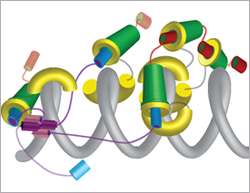Molecular VELCRO for chromosome stability

(Phys.org) —A team of scientists at the Friedrich Miescher Institute for Biomedical Research and the University of Geneva has functionally dissected the molecular processes that ensure the stability of chromosomes. They show in the renowned scientific journal Cell, how three proteins interact on the repetitive sequences at the chromosomal ends, the telomeres, to form a powerful protein scaffold required for telomere homeostasis.
The genome is full of sequence repetitions. Sequence motive is added after sequence motive, sometimes more than a hundred times. Erratically it seems. And these sequence motives bind proteins that control transcription factors in regions of the genome where no transcription should occur. A conundrum.
Nicolas Thomä, group leader at the Friedrich Miescher Institute for Biomedical Research, and his team together with the team of David Shore at the University of Geneva, have now been able to give an answer and assign a function to this seeming inconsistency. In a study published today in Cell, they elucidated how sequence repeats in telomeres help stabilize these regions and prevent cell death.
Telomeres are at the ends of chromosomes and are composed of DNA repeats. With each cell division, because of the nature of DNA replication, one strand of the DNA becomes shorter and would hence trigger processes leading to cell cycle arrest and eventually cell death. There are a variety of processes in place to ensure that both DNA strands are maintained and that the loss of telomeric sequences through unwanted degradation is minimal. One strategy that has been known for a while is the protective capping of the telomeric ends using a set of dedicated proteins.
Thomä and his colleagues have now dissected the molecular, biochemical and functional properties of the protein cap called telosome. They show by X-ray structural analysis that the common transcription factor Rap1 at the telomeres interacts with two proteins called Rif1 and Rif2 and thus forms a higher-order structure that protects the telomeres. In a VELCRO-like manner up to 20 Rap1 molecules sitting on the DNA repeats are tightly linked to each other through the Rif proteins, where Rif2 and Rif1 link neighboring Rap1s. Only once this higher-order structure is in place, the chromosomal ends are protected from degradation and the cell sidesteps cell death.
"In this study we have been able to shed light on the role of sequence repetitions in telomere stability and how a general transcription factor forms the basis for a functionally very powerful protein scaffold that controls telomere homeostasis," said Thomä. "This is a novel concept and could explain how other regions of the genome with sequence repetitions function to control transcription and cell fate."
More information: Shi, T. et al. (2013) Rif1 and Rif2 shape telomere function and architecture through multivalent Rap1 interactions, Cell.
Journal information: Cell


















